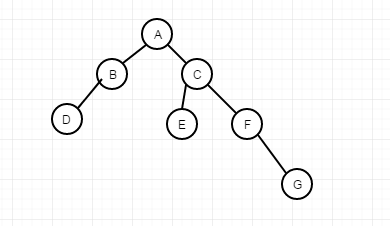一、概念
二叉搜索樹也成二叉排序樹,它有這么一個特點,某個節點,若其有兩個子節點,則一定滿足,左子節點值一定小于該節點值,右子節點值一定大于該節點值,對于非基本類型的比較,可以實現comparator接口,在本文中為了方便,采用了int類型數據進行操作。
要想實現一顆二叉樹,肯定得從它的增加說起,只有把樹構建出來了,才能使用其他操作。
二、二叉搜索樹構建
談起二叉樹的增加,肯定先得構建一個表示節點的類,該節點的類,有這么幾個屬性,節點的值,節點的父節點、左節點、右節點這四個屬性,代碼如下
|
1
2
3
4
5
6
7
8
9
10
11
12
13
14
15
16
17
18
19
|
static class node{ node parent; node leftchild; node rightchild; int val; public node(node parent, node leftchild, node rightchild,int val) { super(); this.parent = parent; this.leftchild = leftchild; this.rightchild = rightchild; this.val = val; } public node(int val){ this(null,null,null,val); } public node(node node,int val){ this(node,null,null,val); } } |
這里采用的是內部類的寫法,構建完節點值后,再對整棵樹去構建,一棵樹,先得有根節點,再能延伸到余下子節點,那在這棵樹里,也有一些屬性,比如基本的根節點root,樹中元素大小size,這兩個屬性,如果采用了泛型,可能還得增加comparator屬性,或提供其一個默認實現。具體代碼如下
|
1
2
3
4
5
6
7
|
public class searchbinarytree { private node root; private int size; public searchbinarytree() { super(); }} |
三、增加
當要進行添加元素的時候,得考慮根節點的初始化,一般情況有兩種、當該類的構造函數一初始化就對根節點root進行初始化,第二種、在進行第一次添加元素的時候,對根節點進行添加。理論上兩個都可以行得通,但通常采用的是第二種懶加載形式。
在進行添加元素的時候,有這樣幾種情況需要考慮
一、添加時判斷root是否初始化,若沒初始化,則初始化,將該值賦給根節點,size加一。
二、因為二叉樹搜索樹滿足根節點值大于左節點,小于右節點,需要將插入的值,先同根節點比較,若大,則往右子樹中進行查找,若小,則往左子樹中進行查找。直到某個子節點。
這里的插入實現,可以采用兩種,一、遞歸、二、迭代(即通過while循環模式)。
3.1、遞歸版本插入
|
1
2
3
4
5
6
7
8
9
10
11
12
13
14
15
16
17
18
19
20
21
22
23
24
25
26
27
28
29
30
31
32
33
34
35
36
37
38
39
40
41
42
43
44
45
46
47
48
49
50
51
52
53
54
55
|
public boolean add(int val){ if(root == null){ root = new node(val); size++; return true; } node node = getadapternode(root, val); node newnode = new node(val); if(node.val > val){ node.leftchild = newnode; newnode.parent = node; }else if(node.val < val){ node.rightchild = newnode; newnode.parent = node; }else{ // 暫不做處理 } size++;19 return true; } /** * 獲取要插入的節點的父節點,該父節點滿足以下幾種狀態之一 * 1、父節點為子節點 * 2、插入節點值比父節點小,但父節點沒有左子節點 * 3、插入節點值比父節點大,但父節點沒有右子節點 * 4、插入節點值和父節點相等。 * 5、父節點為空 * 如果滿足以上5種情況之一,則遞歸停止。 * @param node * @param val * @return */ private node getadapternode(node node,int val){ if(node == null){ return node; } // 往左子樹中插入,但沒左子樹,則返回 if(node.val > val && node.leftchild == null){ return node; } // 往右子樹中插入,但沒右子樹,也返回 if(node.val < val && node.rightchild == null){ return node; } // 該節點是葉子節點,則返回 if(node.leftchild == null && node.rightchild == null){ return node; } if(node.val > val && node.leftchild != null){ return getadaptarnode(node.leftchild, val); }else if(node.val < val && node.rightchild != null){ return getadaptarnode(node.rightchild, val); }else{ return node; } } |
使用遞歸,先找到遞歸的結束點,再去把整個問題化為子問題,在上述代碼里,邏輯大致是這樣的,先判斷根節點有沒有初始化,沒初始化則初始化,完成后返回,之后通過一個函數去獲取適配的節點。之后進行插入值。
3.2、迭代版本
|
1
2
3
4
5
6
7
8
9
10
11
12
13
14
15
16
17
18
19
20
21
22
23
24
25
26
27
28
29
30
31
32
33
34
35
36
37
|
public boolean put(int val){ return putval(root,val); } private boolean putval(node node,int val){ if(node == null){// 初始化根節點 node = new node(val); root = node; size++; return true; } node temp = node; node p; int t; /** * 通過do while循環迭代獲取最佳節點, */ do{ p = temp; t = temp.val-val; if(t > 0){ temp = temp.leftchild; }else if(t < 0){ temp = temp.rightchild; }else{ temp.val = val; return false; } }while(temp != null); node newnode = new node(p, val); if(t > 0){ p.leftchild = newnode; }else if(t < 0){ p.rightchild = newnode; } size++; return true; } |
原理其實和遞歸一樣,都是獲取最佳節點,在該節點上進行操作。
論起性能,肯定迭代版本最佳,所以一般情況下,都是選擇迭代版本進行操作數據。
四、刪除
可以說在二叉搜索樹的操作中,刪除是最復雜的,要考慮的情況也相對多,在常規思路中,刪除二叉搜索樹的某一個節點,肯定會想到以下四種情況,

1、要刪除的節點沒有左右子節點,如上圖的d、e、g節點
2、要刪除的節點只有左子節點,如b節點
3、要刪除的節點只有右子節點,如f節點
4、要刪除的節點既有左子節點,又有右子節點,如 a、c節點
對于前面三種情況,可以說是比較簡單,第四種復雜了。下面先來分析第一種
若是這種情況,比如 刪除d節點,則可以將b節點的左子節點設置為null,若刪除g節點,則可將f節點的右子節點設置為null。具體要設置哪一邊,看刪除的節點位于哪一邊。
第二種,刪除b節點,則只需將a節點的左節點設置成d節點,將d節點的父節點設置成a即可。具體設置哪一邊,也是看刪除的節點位于父節點的哪一邊。
第三種,同第二種。
第四種,也就是之前說的有點復雜,比如要刪除c節點,將f節點的父節點設置成a節點,f節點左節點設置成e節點,將a的右節點設置成f,e的父節點設置f節點(也就是將f節點替換c節點),還有一種,直接將e節點替換c節點。那采用哪一種呢,如果刪除節點為根節點,又該怎么刪除?
對于第四種情況,可以這樣想,找到c或者a節點的后繼節點,刪除后繼節點,且將后繼節點的值設置為c或a節點的值。先來補充下后繼節點的概念。
一個節點在整棵樹中的后繼節點必滿足,大于該節點值得所有節點集合中值最小的那個節點,即為后繼節點,當然,也有可能不存在后繼節點。
但是對于第四種情況,后繼節點一定存在,且一定在其右子樹中,而且還滿足,只有一個子節點或者沒有子節點兩者情況之一。具體原因可以這樣想,因為后繼節點要比c節點大,又因為c節點左右子節一定存在,所以一定存在右子樹中的左子節點中。就比如c的后繼節點是f,a的后繼節點是e。
有了以上分析,那么實現也比較簡單了,代碼如下
|
1
2
3
4
5
6
7
8
9
10
11
12
13
14
15
16
17
18
19
20
21
22
23
24
25
26
27
28
29
30
31
32
33
34
35
36
37
38
39
40
41
42
43
44
45
46
47
48
49
50
51
52
53
54
55
56
57
58
59
60
61
62
63
64
65
66
67
68
69
70
71
72
73
74
75
76
77
78
79
|
public boolean delete(int val){ node node = getnode(val); if(node == null){ return false; } node parent = node.parent; node leftchild = node.leftchild; node rightchild = node.rightchild; //以下所有父節點為空的情況,則表明刪除的節點是根節點 if(leftchild == null && rightchild == null){//沒有子節點 if(parent != null){ if(parent.leftchild == node){ parent.leftchild = null; }else if(parent.rightchild == node){ parent.rightchild = null; } }else{//不存在父節點,則表明刪除節點為根節點 root = null; } node = null; return true; }else if(leftchild == null && rightchild != null){// 只有右節點 if(parent != null && parent.val > val){// 存在父節點,且node位置為父節點的左邊 parent.leftchild = rightchild; }else if(parent != null && parent.val < val){// 存在父節點,且node位置為父節點的右邊 parent.rightchild = rightchild; }else{ root = rightchild; } node = null; return true; }else if(leftchild != null && rightchild == null){// 只有左節點 if(parent != null && parent.val > val){// 存在父節點,且node位置為父節點的左邊 parent.leftchild = leftchild; }else if(parent != null && parent.val < val){// 存在父節點,且node位置為父節點的右邊 parent.rightchild = leftchild; }else{ root = leftchild; } return true; }else if(leftchild != null && rightchild != null){// 兩個子節點都存在 node successor = getsuccessor(node);// 這種情況,一定存在后繼節點 int temp = successor.val; boolean delete = delete(temp); if(delete){ node.val = temp; } successor = null; return true; } return false; } /** * 找到node節點的后繼節點 * 1、先判斷該節點有沒有右子樹,如果有,則從右節點的左子樹中尋找后繼節點,沒有則進行下一步 * 2、查找該節點的父節點,若該父節點的右節點等于該節點,則繼續尋找父節點, * 直至父節點為null或找到不等于該節點的右節點。 * 理由,后繼節點一定比該節點大,若存在右子樹,則后繼節點一定存在右子樹中,這是第一步的理由 * 若不存在右子樹,則也可能存在該節點的某個祖父節點(即該節點的父節點,或更上層父節點)的右子樹中, * 對其迭代查找,若有,則返回該節點,沒有則返回null * @param node * @return */ private node getsuccessor(node node){ if(node.rightchild != null){ node rightchild = node.rightchild; while(rightchild.leftchild != null){ rightchild = rightchild.leftchild; } return rightchild; } node parent = node.parent; while(parent != null && (node == parent.rightchild)){ node = parent; parent = parent.parent; } return parent; } |
具體邏輯,看上面分析,這里不作文字敘述了,
除了這種實現,在算法導論書中,提供了另外一種實現。
|
1
2
3
4
5
6
7
8
9
10
11
12
13
14
15
16
17
18
19
20
21
22
23
24
25
26
27
28
29
30
31
32
33
34
35
36
37
38
39
40
41
42
43
44
45
46
47
48
49
|
public boolean remove(int val){ node node = getnode(val); if(node == null){ return false; } if(node.leftchild == null){// 1、左節點不存在,右節點可能存在,包含兩種情況 ,兩個節點都不存在和只存在右節點 transplant(node, node.rightchild); }else if(node.rightchild == null){//2、左孩子存在,右節點不存在 transplant(node, node.leftchild); }else{// 3、兩個節點都存在 node successor = getsuccessor(node);// 得到node后繼節點 if(successor.parent != node){// 后繼節點存在node的右子樹中。 transplant(successor, successor.rightchild);// 用后繼節點的右子節點替換該后繼節點 successor.rightchild = node.rightchild;// 將node節點的右子樹賦給后繼節點的右節點,即類似后繼與node節點調換位置 successor.rightchild.parent = successor;// 接著上一步 給接過來的右節點的父引用復制 } transplant(node, successor); successor.leftchild = node.leftchild; successor.leftchild.parent = successor; } return true; } /** * 將child節點替換node節點 * @param root 根節點 * @param node 要刪除的節點 * @param child node節點的子節點 */ private void transplant(node node,node child){ /** * 1、先判斷 node是否存在父節點 * 1、不存在,則child替換為根節點 * 2、存在,則繼續下一步 * 2、判斷node節點是父節點的那個孩子(即判斷出 node是右節點還是左節點), * 得出結果后,將child節點替換node節點 ,即若node節點是左節點 則child替換后 也為左節點,否則為右節點 * 3、將node節點的父節點置為child節點的父節點 */ if(node.parent == null){ this.root = child; }else if(node.parent.leftchild == node){ node.parent.leftchild = child; }else if(node.parent.rightchild == node){ node.parent.rightchild = child; } if(child != null){ child.parent = node.parent; } } |
五、查找
查找也比較簡單,其實在增加的時候,已經實現了。實際情況中,這部分可以抽出來單獨方法。代碼如下
|
1
2
3
4
5
6
7
8
9
10
11
12
13
14
15
|
public node getnode(int val){ node temp = root; int t; do{ t = temp.val-val; if(t > 0){ temp = temp.leftchild; }else if(t < 0){ temp = temp.rightchild; }else{ return temp; } }while(temp != null); return null; } |
六、二叉搜索樹遍歷
在了解二叉搜索樹的性質后,很清楚的知道,它的中序遍歷是從小到大依次排列的,這里提供中序遍歷代碼
|
1
2
3
4
5
6
7
8
9
10
|
public void print(){ print(root); } private void print(node root){ if(root != null){ print(root.leftchild); system.out.println(root.val);// 位置在中間,則中序,若在前面,則為先序,否則為后續 print(root.rightchild); } } |
總結
以上所述是小編給大家介紹的java實現 二叉搜索樹功能,希望對大家有所幫助,如果大家有任何疑問歡迎給我留言,小編會及時回復大家的!
原文鏈接:https://www.cnblogs.com/qm-article/p/9279655.html













